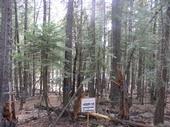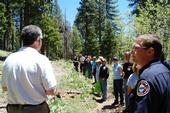- Posted By: Sophie Kolding
- Written by: Michael De Lasaux

The Plumas County Fire Safe Council has coordinated multi-parcel fuel reduction in 13 communities since 2002. The Council began with a county-wide demonstration project in 2002 that treated 62 acres and has since implemented projects on nearly 2,000 acres. As a Natural Resource Advisor in Plumas and Sierra Counties, I have conducted comprehensive monitoring of 7 of the projects.
Coordinated community fuel reduction includes multiple property owners who often have little experience with forest management projects that involve tree thinning to reduce the accumulated fuel hazard. The property owners value their property for aesthetics, wildlife viewing, recreation and other reasons, but they often knew very little about forest...
- Posted By: Richard B Standiford
- Written by: Sarah Yang
Genetic detective work by an international group of researchers may have solved a decades-long mystery of the source of a devastating tree-killing fungus that has hit six of the world's seven continents.
In a study published September 1, in the peer-reviewed journal Phytopathology, California emerged as the top suspect for the pathogen, Seiridium cardinale, that is the cause of cypress canker disease.
It was in California’s San Joaquin Valley in 1928 that S. cardinale was first identified as the culprit causing the disease. The fungus has made its way since to Europe, Asia, New Zealand, Australia, South America and Africa. In many regions, the pathogen has infected and killed up to 95 percent...
- Author: Jaime Adler

Re-posted from UC Berkeley Department of Environmental Science, Policy, and Management.
This image from a Nelder Plot at Blodgett Forest Research Station in the Sierra Nevada mountains is part of a study designed to find out how trees respond to different levels of competition for resources (light, water, and nutrients). The wagon-wheel pattern provides a space-efficient way to experimentally increase tree density as one gets closer to the center of the “spokes.”
The trees in the image are giant sequoia, a species that is particularly sensitive to competition. After only a few years, one can see from the image that trees near the...
- Posted By: Jaime Adler
- Written by: Gareth J Mayhead

Last week I visited Trinity River Lumber (TRL), a sawmill, in Weaverville, California. The sawmill was almost totally destroyed by a fire in September 2009 and completed rebuilding in January this year. The mill is the largest private employer in Trinity County with approximately 115 full time jobs. The community was relieved that TRL’s owner chose to rebuild the mill after the fire. The new mill is impressive in its versatility to saw a range of products and in its use of technology to maximize production. Both the pony (small log) and main headrig saws make use of 3D scanners to optimize lumber yield from each log. They are currently increasing production to approximately 120,000,000 board feet of lumber per year. The main...
- Posted By: Jaime Adler
- Written by: Susie Kocher, UCCE Advisor

Wildfire Summit pulls together Tahoe basin residents and agencies on the fourth anniversary of the 2007 Angora fire to improve implementation of defensible space
The Lake Tahoe Wildfire Summit was held in Tahoe City on June 24th, 2011, four years after the Angora fire which started on June 24th, 2007 in South Lake Tahoe. The summit drew together over 100 basin residents, agency staff and policy makers to focus on ways to reduce wildfire risks to Tahoe homes and communities. Presentations centered on wildfire issues in the Tahoe Basin and how to reduce risk to homes and communities by creating defensible space, improving building materials and design, and implementing forest fuels reduction...


